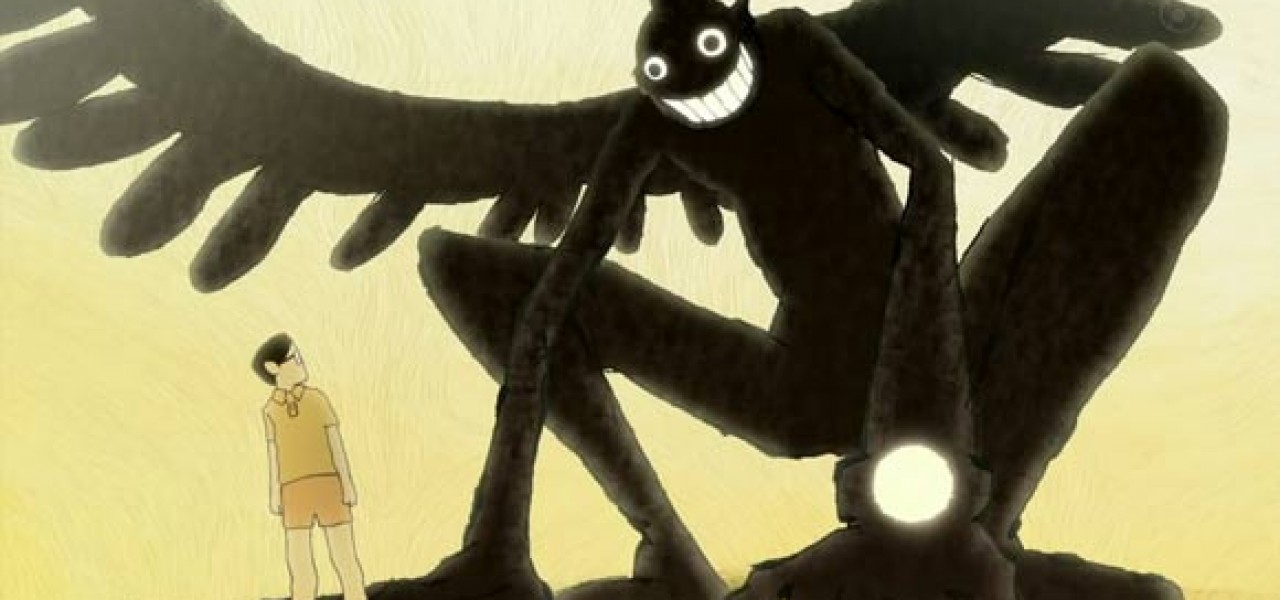
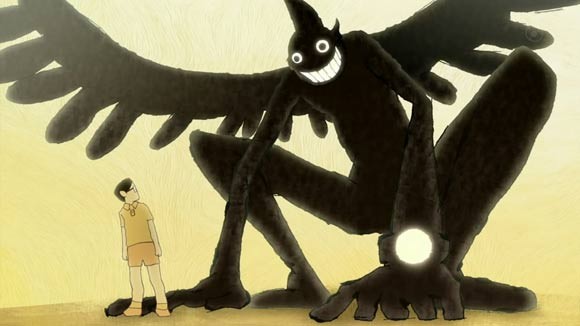
‘Ping Pong’ Recap: ‘Staking Your Life On Table Tennis is Revolting’ (Ep. 3)

Tensions run high during the high school championships, and all eyes are on the showdown between Kong and Smile.
The third episode jumps abruptly from Smile’s training in episode 2 right to the championships, and to a Smile who has begun to gain the confidence to show his true potential.
The championships bring together the various rivals who were only mentioned in previous episodes. Each has a different motive for wanting to win, reflected in their playing style: Kong attacks aggressively because his back is against the wall. He can’t afford Smile’s carefree attitude because losing means the end of his career.
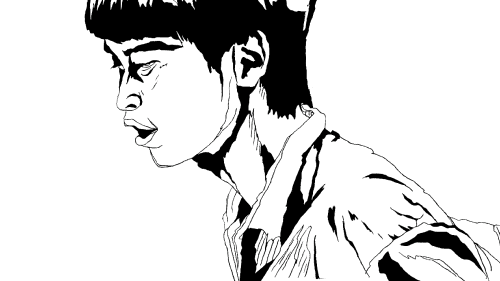
What keeps Smile from achieving greatness isn’t laziness. It’s compassion. He’s unwilling to see his opponent as anything other than a vulnerable human being. To do so would be to become like Kong, part of the system, an automaton of blind ambition. It’s his rebellion against the system, his way of dropping out. Before his match with Kong, coach Koizumi warns Smile that holding back is his greatest weakness. Indeed, just as Smile appears poised to win, he gives in because he knows what’s at stake for Kong.
Episode two was filled with butterfly metaphors. Again, while speaking to his wife at home at the beginning of episode 3, Coach Koizumi likens Smile to a butterfly on the cusp of hatching from his cocoon. Just then, a Roomba bounces off of his foot, echoing the epithet hurled at Smile by his peers in the previous episode.
This episode was briskly paced and had great rhythm, but the quality was obviously struggling and in some spots lacking. Excessive stills plagued the climactic battle and other moments such as crowd scenes, which would have benefited from a little more movement. The show’s brutally short schedule takes its toll. Tight schedules are nothing new for Yuasa’s productions, but this time things appear particularly bad. Shots such as Sakuma walking towards the bus in sliding stills make me envision a director struggling valiantly to put together a final product without all the animation he needs.
Masaaki Yuasa storyboards again, and this time the episode director is Masatsugu Arakawa. Arakawa is a great animator in his own right. Like Masaaki Yuasa, he began his career at animation subcontracting studio Ajia-Do, and the two actually worked together on a 30-minute direct-to-video short entitled Ahoy there, Little Polar Bear! in 1991, though this was early in their careers and doesn’t represent their mature styles. This is their first time working together since.
Like many Ajia-Do animators, Arakawa has a unique style that’s loose, tactile and angular, favoring rough and spontaneous drawings over superficially pretty and detailed drawings. When given the chance to work in his style, he produces beautiful and unique animation, as in the case of Production IG’s Windy Tales TV show from 2004.
Ping Pong already has a strong visual style dictated by the manga, so Arakawa’s drawing style takes a back seat to Taiyo Matsumoto’s. Still, you can spot his drawings here and there. His characters are identifiable by their diamond eyes, the straighter and cleaner lines, and a particular kind of pared down realistic caricature reminiscent of his 1998 animated Playstation game Yukiwari no Hana.
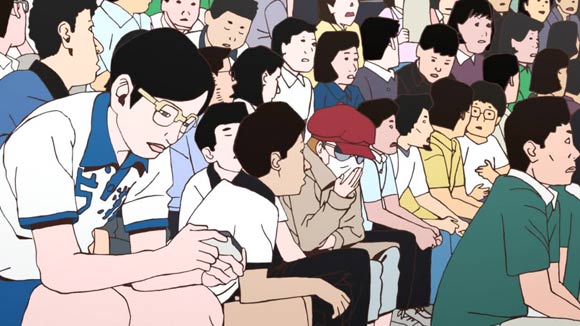
From scene to scene, you can also identify the styles of the episode’s various other animators at play. Even if not always specifically faithful to Taiyo Matsumoto’s style, Ping Pong‘s drawings retain the spirit of the jagged and roughly drawn original. The setting of this episode, with its bleachers full of onlookers, provide for lots of fantastic character sketches. The natural posing and sketchbook realism of the drawings saves the animation from being boring due to lack of movement. Every shot has something interesting to look at.
Taiyo Matsumoto’s peculiar design style comes out in Peco’s rival, the slant-eyed Sakuma from Kaio who head-butts Peco. Taiyo Matsumoto also has a particular way of drawing overly large hands with elongated, chunky, clumsily drawn fingers and foreshortened palms, and the anime captures this in a lot of shots.
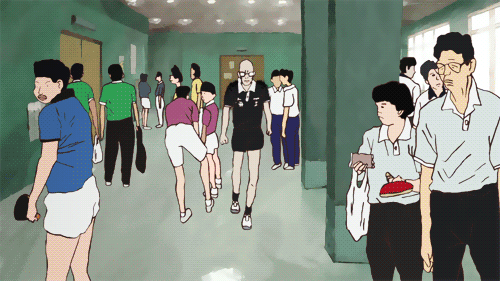
The most interesting name in the credits this time around is Bahi JD, but unfortunately it appears his animation of the climactic scene didn’t make it into the final product. The drawings of this scene instead adhere fairly closely to the original manga, almost to the point of tracing the manga’s drawings, relying a little too much on stills. The great rhythm of the directing makes the scene work, but the scene could have been more if it moved properly.
Last but not least, we finally have a proper opening. And it’s quite a doozy, produced by Shinya Ohira, the legendary animator whose uncompromising stance and style make him an icon in the industry. Drawn almost entirely in black and white to accentuate the focus on pure hand-drawn line animation, the opening is flagrantly, proudly hand-drawn. It’s an intense explosion of movement replete with a mess of pencil strokes they make no effort to hide. Odd effects are thrown in and characters’ bodies and faces are wobble expressively to heighten the dynamism. It’s animation at its most primal and visceral. The visuals finally match the punk feeling of the song.
As in the case of the opening Ohira produced for the TV show Sci-Fi Harry in 2000, each section is animated by a different animator with a completely different style. Not only is no effort made to hide the different styles, the opening almost comes across as a celebration of those different styles. Ohira’s animation defies assimilation. His animation is about the visceral thrill of pure movement, not about selling a product. In that sense, he’s like Smile, playing only for the sheer fun of it and refusing any attempt at corruption.
Ohira and Masaaki Yuasa have a long history of working together. Together they produced one of the few real masterpieces of anime in 1994 with Hamaji’s Resurrection, an episode in the direct-to-video series The Hakkenden:
Aside from the animation, another detail that pleases me about the show is how the Mandarin spoken by Kong and his coach is accurate. Too often in anime they don’t bother to get the foreign languages right, and it makes for embarrassing viewing that takes you out of the zone. It’s a sign of respect to go that extra mile, not to mention diligence as a director. I like how his character lends the show plausibility. It would make the show feel inauthentic if the Mandarin wasn’t spoken with such authority and confidence in the inflection and emotion. Kong wouldn’t be Kong, with his gung-ho self-confidence and swagger. Credit to voice-actor Wen Yexing for making Kong feel real.
Ping Pong Episode 3: Staking your life on table tennis is revolting
| Storyboard: Script: Series Structure: |
Masaaki Yuasa | |
| Episode Director: | Masatsugu Arakawa | |
| Animation Director: | Nobutake Ito | Sayaka Toda |
| Key Animation: | Tetsuro Kaku | Yasunori Miyazawa |
| Satoshi Nakano | Maki Kawake | |
| Yuichiro Komuro | Saori Koike | |
| Ran Kamezawa | Yuki Matsuo | |
| Hiromi Hata | Masahiko Matsuyama | |
| Hayao Enomoto | Takahito Sakazume | |
| Maiko Kobayashi | Bahi JD | |
| Kenji Shibata | Kenji Hayama | |
| Masatsugu Arakawa | ||
| Flash Animation: | Science SARU | |
| Juan Manuel Laguna | Abel Gongora | |
| Thomas Hudson |
Opening animation
| Storyboard: Director: Animation Director: |
Shinya Ohira | |
| Key Animation: | Ryosuke Sakai | Kusunoki Nishiajima |
| Wu Boyu | Tomiyuki Niho | |
| Hokuto Sakiyama | Yasunori Miyazawa | |
| Shinji Hashimoto | Shinya Ohira |

.png)